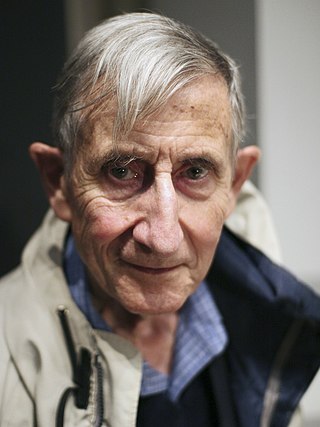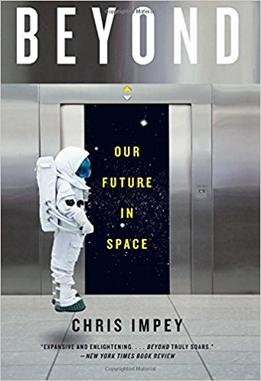
A Dyson sphere is a hypothetical megastructure that encompasses a star and captures a large percentage of its solar power output. The concept is a thought experiment that attempts to imagine how a spacefaring civilization would meet its energy requirements once those requirements exceed what can be generated from the home planet's resources alone. Because only a tiny fraction of a star's energy emissions reaches the surface of any orbiting planet, building structures encircling a star would enable a civilization to harvest far more energy.

Freeman John Dyson was a British-American theoretical physicist and mathematician known for his works in quantum field theory, astrophysics, random matrices, mathematical formulation of quantum mechanics, condensed matter physics, nuclear physics, and engineering. He was professor emeritus in the Institute for Advanced Study in Princeton and a member of the board of sponsors of the Bulletin of the Atomic Scientists.

Space colonization is the use of outer space for colonization, such as permanent habitation, exploitation or territorial claims. Extraterrestrial colonization is its broader form, including the use of celestial bodies, other than Earth, for colonization.

The Kardashev scale is a method of measuring a civilization's level of technological advancement based on the amount of energy it is capable of harnessing and using. The measure was proposed by Soviet astronomer Nikolai Kardashev (1932–2019) in 1964 and was named after him.

Technological utopianism is any ideology based on the premise that advances in science and technology could and should bring about a utopia, or at least help to fulfill one or another utopian ideal.
The information superhighway is a late-20th-century phrase that aspirationally referred to the increasingly mainstream availability of digital communication systems.

Gerard Kitchen O'Neill was an American physicist and space activist. As a faculty member of Princeton University, he invented a device called the particle storage ring for high-energy physics experiments. Later, he invented a magnetic launcher called the mass driver. In the 1970s, he developed a plan to build human settlements in outer space, including a space habitat design known as the O'Neill cylinder. He founded the Space Studies Institute, an organization devoted to funding research into space manufacturing and colonization.
Megascale engineering is a form of exploratory engineering concerned with the construction of structures on an enormous scale. Typically these structures are at least 1,000 km (620 mi) in length—in other words, at least one megameter, hence the name. Such large-scale structures are termed megastructures.

Astrochicken is the name given to a thought experiment expounded by theoretical physicist Freeman Dyson. An Astrochicken is a small, one-kilogram spacecraft, a self-replicating automaton that could explore space more efficiently than a crewed craft could due to its innovative mix of technology.
Leapfrogging is a concept used in many domains of the economics and business fields, and was originally developed in the area of industrial organization and economic growth. The main idea behind the concept of leapfrogging is that small and incremental innovations lead a dominant firm to stay ahead. However, sometimes, radical innovations will permit new firms to leapfrog the ancient and dominant firm. The phenomenon can occur to firms but also to leadership of countries or cities, where a developing country can skip stages of the path taken by industrial nations, enabling them to catch up sooner, particularly in terms of economic growth.
The Commonwealth Saga is a series of science fiction novels by British science fiction writer Peter F. Hamilton. This saga consists of the novels Pandora's Star (2004) and Judas Unchained (2005). Hamilton has also written several books set in the same literary universe. Misspent Youth (2002) takes place 340 years before the events of Pandora's Star. The Void Trilogy, consisting of The Dreaming Void (2008), The Temporal Void (2009), and The Evolutionary Void (2010), takes place 1,200 years after the events of Judas Unchained; several of the main characters from Judas Unchained and Pandora's Star also appear in the Void trilogy.
World energy resources are the estimated maximum capacity for energy production given all available resources on Earth. They can be divided by type into fossil fuel, nuclear fuel and renewable resources.
The NASA Decadal Planning Team (DPT) and its successor, the NASA Exploration Team (NExT), were influential behind-the-scenes efforts to develop a major new direction for the space agency early in the 21st Century.

The global brain is a neuroscience-inspired and futurological vision of the planetary information and communications technology network that interconnects all humans and their technological artifacts. As this network stores ever more information, takes over ever more functions of coordination and communication from traditional organizations, and becomes increasingly intelligent, it increasingly plays the role of a brain for the planet Earth. In the philosophy of mind, global brain finds an analog in Averroes's theory of the unity of the intellect.
The social data revolution is the shift in human communication patterns towards increased personal information sharing and its related implications, made possible by the rise of social networks in the early 2000s. This phenomenon has resulted in the accumulation of unprecedented amounts of public data.
Engineering on an astronomical scale, or astronomical engineering, i.e., engineering involving operations with whole astronomical objects, is a known theme in science fiction, as well as a matter of recent scientific research and exploratory engineering.

Physics of the Future: How Science Will Shape Human Destiny and Our Daily Lives by the Year 2100 is a 2011 book by theoretical physicist Michio Kaku, author of Hyperspace and Physics of the Impossible. In it Kaku speculates about possible future technological development over the next 100 years. He interviews notable scientists about their fields of research and lays out his vision of coming developments in medicine, computing, artificial intelligence, nanotechnology, and energy production. The book was on the New York Times Bestseller List for five weeks.

Technosignature or technomarker is any measurable property or effect that provides scientific evidence of past or present technology. Technosignatures are analogous to biosignatures, which signal the presence of life, whether intelligent or not. Some authors prefer to exclude radio transmissions from the definition, but such restrictive usage is not widespread. Jill Tarter has proposed that the search for extraterrestrial intelligence (SETI) be renamed "the search for technosignatures". Various types of technosignatures, such as radiation leakage from megascale astroengineering installations such as Dyson spheres, the light from an extraterrestrial ecumenopolis, or Shkadov thrusters with the power to alter the orbits of stars around the Galactic Center, may be detectable with hypertelescopes. Some examples of technosignatures are described in Paul Davies's 2010 book The Eerie Silence, although the terms "technosignature" and "technomarker" do not appear in the book.

Beyond: Our Future in Space is a non-fiction book by astronomer and professor Chris Impey that discusses the history of space travel and the future trajectory of human exploration of space. Impey's third popular science book for Norton was published as a hardcover in 2015.

Iain McCulloch is Professor of Polymer Chemistry, in the Department of Chemistry, at the University of Oxford, UK, a fellow and tutor in chemistry at Worcester College, and an adjunct professor at King Abdullah University of Science and Technology (KAUST), Saudi Arabia, and a visiting professor in the Department of Chemistry at Imperial College London.












